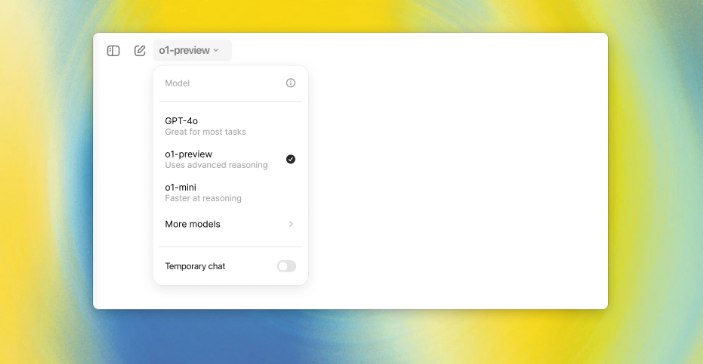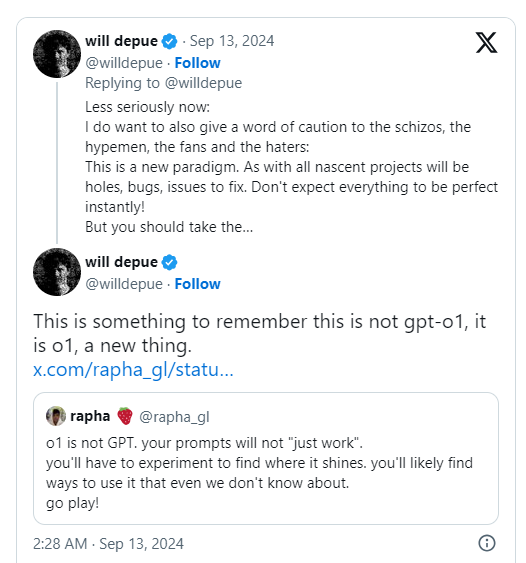OpenAI has launched a new series of inference models, OpenAI o1, which includes o1-preview and the smaller and more economical o1-mini model. The o1 series has significantly improved its reasoning capabilities, especially o1-mini, which performs well in code generation and debugging, has lower cost, and is suitable for various application scenarios. ChatGPT Plus and Team users are already available, and will be expanded to more users and developers in the future. OpenAI emphasizes that the o1 model prefers simple and direct prompts without complex guidance, and recommends that users avoid using "chain of thought" prompts, use delimiters to improve understanding efficiency, and limit additional contextual information to obtain the best results. Compared with previous models, the o1 model focuses more on its own reasoning capabilities, demonstrating the progress of AI technology.
OpenAI also launched a smaller model, OpenAI o1-mini, which performs well in code generation and debugging, is lower cost, and is suitable for applications that require reasoning but do not require extensive knowledge.
As a smaller model, o1-mini is 80% cheaper than o1-preview, making it a powerful, cost-effective model for applications that require inference but do not require extensive world knowledge.
How to use OpenAI o1
Starting today, ChatGPT Plus and Team users can find o1-preview and o1-mini options in model selection.
Next, ChatGPT Enterprise and Edu users will also gain access to both models. For developers, users who meet the API usage conditions can already start using these two models for prototype development.
In the future, officials will continue to update these inference models and add more practical functions, including browsing and file uploading, to ensure a better experience for users.

However, to take full advantage of this new model, users will need to adjust their prompting methods, because the way OpenAIo1 works is very different from GPT-4 and even GPT-4o.
According to OpenAI's API documentation, the OpenAIo1 model prefers simple and direct prompts.
Prompt engineering design, simplify model guidance
That is, users don’t need to be given complex instructions or lengthy context as in the past . Previous models required more guidance, and users often took advantage of longer context windows to help the model understand the task, but OpenAIo1 already has stronger internal reasoning capabilities, so these lengthy instructions are no longer needed.
OpenAI also reminds users to pay attention to the following points when using the o1 model:
- Tip: Keep it simple, direct, and not overly directive, as this model understands instructions well.
- Avoid using the "chain of thought" tip, since the o1 model itself is already capable of internal reasoning.
- Use delimiters such as triple quotes, XML tags, and chapter titles so the model has a clearer idea of which section it is parsing.
- Limit additional contextual information, especially when performing Retrieval Augmented Generation (RAG) tasks, as adding too much background information may complicate the model's answers.
This is completely different from OpenAI's previous advice to users. Previously, OpenAI advised users to be very specific, including detailed information and guiding the model step-by-step, but now OpenAIo1 is more able to think on its own and find solutions to problems.
In the blog of Ethan Mollick, a professor at the Wharton School of Business at Penn University, he mentioned that as an early user, he found that OpenAIo1 performed better in tasks that required planning and was able to come up with solutions independently.
Of course, prompt engineering is also becoming increasingly important, becoming not only an important skill but an emerging career category. To this end, other AI developers have also launched tools to facilitate users in designing prompts, such as Google's Prompt Poet, which integrates external data sources to make responses more relevant.
Since OpenAIo1 is different, users are still figuring out how to use it. However, some social media users predict that people will have to change the way they prompt ChatGPT.

Although OpenAI o1 is still new and people are still figuring out how to use it, some users on social media are already predicting that people will need to rethink the way they interact with ChatGPT.
Official blog: https://openai.com/index/introducing-openai-o1-preview/
Product entrance visit: https://top.aibase.com/tool/openai-o1
Highlight:
- The OpenAI o1 model requires simple, direct prompts rather than complex guidance.
- ? Avoid using chain of thought prompts because the o1 model already has internal reasoning capabilities.
- ? Use delimiters to clarify parts of the model parsing and limit additional context to avoid complex answers.
All in all, the launch of the OpenAI o1 series models marks a new stage in the development of large-scale language models. Its powerful reasoning capabilities and more simplified prompt engineering requirements will profoundly affect the way users interact with AI. Users need to adapt to the new prompting strategy to fully realize the potential of the o1 model. Keeping an eye on OpenAI updates will help you better understand and apply this new technology.